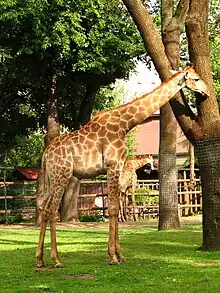| Moscow Zoo | |
|---|---|
 The Moscow Zoo entrance. | |
| 55°45′43″N 37°34′38″E / 55.76194°N 37.57722°E | |
| Date opened | 31 January 1864[1] |
| Location | Moscow, Russia |
| Land area | 21.5 ha (53 acres) |
| No. of animals | 10,531 (2019) |
| No. of species | 1,267 (2019) |
| Memberships | EARAZA,[2] EAZA,[3] WAZA[4] |
| Public transit access | |
| Website | http://moscowzoo.ru/ |
The Moscow Zoo or Moskovsky Zoopark (Russian: Московский зоопарк) is a 21.5-hectare (53-acre) zoo founded in 1864 by professor-biologists, K.F. Rulje, S.A. Usov and A.P. Bogdanov, from the Moscow State University. In 1919, the zoo was nationalized. In 1922, the ownership was transferred to the Government of Moscow and has remained under Moscow's control ever since.[5]
The zoo had an area of 10 hectares (25 acres) when it first opened, with 286 animals. In 1926, the zoo was expanded to adjacent lands, increasing the area to 18 hectares (44 acres). In 1990, the zoo was renovated. Notable additions include a new main entrance in the shape of a large rock castle, and a footbridge that connected the old (1864) and new (1926) properties of the zoo.
In addition, the zoo was expanded once more. New exhibits were opened including a sea aquarium, an aviary, a creatures of the night exhibit, a sea lion exhibit and a section aimed at children.




_02.JPG.webp)

The Moscow zoo has over 7,500 animals representing about 1,000 species and covers an area of about 21.5 hectares (53 acres).[6]
Moscow Zoo Museum
Founded in 2008 in a two-storey building of the 19th century, built in the late XIX - early XX centuries, located on the territory of the zoo. Since 2015, the museum has been open to the public and everyone. In the central and side halls there is an exposition devoted to the history of the Moscow Zoo and a natural science permanent exposition. The collection of the museum includes more than 10,000 zoo coat of arms from all over the world, hundreds of paintings, sculptures and drawings by the masters of Russian animalistics, such as Vasily Vatagin, Alexei Komarov, Vadim Trofimov, Andrei Marts and Alexei Tsvetkov.[7][8][9]
Research & Educational Center
The Moscow Zoo has her own educational institute and research center. In addition to full-training for zoo staff and teachers, there is a continuing education program for zoo and aquarium staff, veterinarians, teachers and volunteers, as well as courses in zoo psychology. Since the Moscow Zoo has been chairman of all zoos in Russia since the Soviet period, it is a national training center. This was founded in 2017 by the current director Svetlana Akulova and Björn Stenvers.[10][11]
Animals & Exhibits
Old Territory exhibits
Flamingo Pond
Giraffe House
Fauna of China
Bird World
Elephant Museum
New Territory exhibits
Animal Island
Outdoors:
- Asiatic lion
- Asian black bear
- Kamchatka brown bear
- Golden jackal
- Tundra wolf
- Striped hyena
- Siberian tiger
Indoors (Exotarium):
Polar World
Tur Hill
Animals of Africa
Former exhibits
Dolphinarium
From 2001 to 2014, the Moscow Zoo Dolphinarium operated on the grounds of the zoo's old territory. The exhibit was dismantled following unsanitary conditions and improper husbandry procedures.
Directors
Directors of the zoo have included:[5]
- Yakov Kalinovsky (1864–1867)
- Sergey Usov (1867–1873)
- Alexandr Maklakov (1878–1880)
- Vladimir Popov (1878–1881)
- Alexandr Chelyukanov (1881–1883)
- Vladimir Wagner (1883–1886)
- Nikolai Kulagin (1889–1894)
- Alexandr Walter (1894–1895)
- Ippolit Antushevich (1895–1904)
- Vladislav Pogorzhelsky (1904–1917)
- Yury Belogolovy (1917–1919)
- Aleksandr Kots (1919–1924)
- Mikhail Zavadovsky (1924–1928)
- Sergey Novikov (1928–1932)
- Yevgeny Klimek (1932–1936)
- Lev Ostrovsky (1936–1940)
- Trofim Burdelev (1940–1950)
- Sergey Butygin (1950–1951)
- Igor Sosnovsky (1951–1977)
- Vladimir Vladimirovich Spitsin (1977–2013)
- Natalya Kolobova (2013–2016)[12]
- Svetlana Akulova (2016–)[13]
Notes
- ↑ "Moscow Zoo (Moscow)". worldwalk.info. WorldWalk.info. Retrieved 15 April 2011.
- ↑ "Zoo Sites". earaza.ru. EARAZA. Retrieved 15 April 2011.
- ↑ "EAZA Member Zoos & Aquariums". eaza.net. EAZA. Retrieved 15 April 2011.
- ↑ "Zoos and Aquariums of the World". waza.org. WAZA. Retrieved 15 April 2011.
- 1 2 Spitsin, Vladimir (2001). Moscow Zoo, Encyclopedia of the World's Zoos, Volume 2. Fitzroy Dearborn. pp. 830, 834. ISBN 1-57958-174-9.
- ↑ "Московский зоопарк".
- ↑ Московский зоопарк. Коллекции
- ↑ Официальный сайт Московского зоопарка. Музей зоопарка
- ↑ KudaGo. Музей истории зоопарка
- ↑ "Moscow Zoo Academy". www.moscowzoo.ru (in Russian). Retrieved 2021-12-22.
- ↑ "Moscow Zoo opens educational institute for employees of Russia". mos.ru (in English and Russian). Retrieved 2021-12-21.
- ↑ "У Московского зоопарка новый начальник". www.mk.ru (in Russian). 17 April 2013. Retrieved 4 December 2023.
- ↑ "Утвержден новый генеральный директор Московского зоопарка". Российская газета (in Russian). 3 October 2016. Retrieved 4 December 2023.
Sources
- Vera Chaplina True Stories from the Moscow Zoo (1970) Englewood Cliffs, New Jersey; Prentice-Hall, Inc. P. 152 (translated by Lila Pargment, Estel Titiev).
- Egorova, L. V., ed. (2004). The Moscow Zoo: History and 140th anniversary (Московский зоологический парк. К 140-летию со дня основания. Страницы истории). Moscow: Ellis Luck 2000. ISBN 978-5-902152-16-3. (in Russian)
External links
![]() Media related to Moscow Zoo at Wikimedia Commons
Media related to Moscow Zoo at Wikimedia Commons
- Official website
- photography Moscow Zoo 2010
- Moscow Zoo on zooinstitutes.com
- Moscow Zoo breeding nursery on zooinstitutes.com
- Moscow Zoo Academy